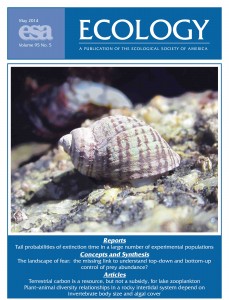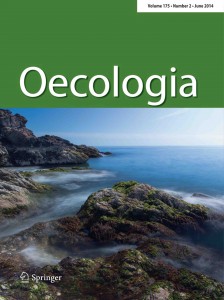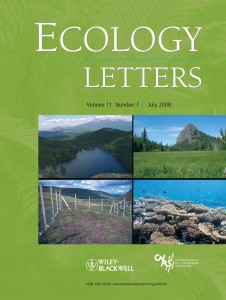
75. Rangel, R.E., M.E.S. Bracken, K.J. Kroeker, L.P. Miller, & C.J.B. Sorte. 2025. Factorial field manipulation reveals CO2 and temperature effects on a critical habitat-forming shellfish. Journal of Experimental Biology 228: jeb.250787. link
74. Bracken, M.E.S., G. Bernatchez, A.J. Badten, & R.A. Chatfield. 2024. Unraveling the multiple facilitative effects of consumers on marine primary producers. Ecology 105: e4439. (cover photo) link
73. Dawkins, P.D, A. Paz-Lacavex, E.A. Fiorenza, M.A. Rush, R. Beas-Luna, J. Lorda, L. Malpica-Cruz, J.M. Sandoval-Gil, T.A. McHugh, M.K. Han, M.E.S. Bracken, & J.B. Lamb. 2024. Field collection and laboratory maintenance of canopy-forming giant kelp to facilitate restoration. Journal of Visualized Experiments 208: e66092. link
72. Lees, L.E., S.N.Z. Jordan, & M.E.S. Bracken. 2024. Kelps may compensate for low nitrate availability by using regenerated forms of nitrogen, including urea and ammonium. Journal of Phycology 60:768-777. link
71. Mahanes, S.A., C.J.B. Sorte, & M.E.S. Bracken. 2023. The functional effects of a dominant consumer are altered following the loss of a dominant producer. Ecology and Evolution 13:e10342. link
70. Sorte, C.J.B., K.J. Kroeker, L.P. Miller, & M.E.S. Bracken. 2023. Biological modification of coastal pH depends on community composition and time. Ecology 104: e4113. link
69. Bedgood, S.A., S.T. Levell, & M.E.S. Bracken. 2023. Sea anemone microhabitats enhance the diversity and biomass of mobile invertebrates on temperate rocky shores. Marine Ecology Progress Series 715: 57-68. link
68. Mahanes, S.A., M.E.S. Bracken, & C.J.B. Sorte. 2022. Climate change amelioration by marine producers: Does dominance predict impact? Biological Bulletin 243: 299-314. link
67. Bracken, M.E.S., L.P. Miller, S.E. Mastroni, S.M. Lira, & C.J.B. Sorte. 2022. Accounting for variation in temperature and oxygen availability when quantifying marine ecosystem metabolism. Scientific Reports 12: 825. link
66. Elsberry, L.A. and M.E.S. Bracken. 2021. Functional redundancy buffers mobile invertebrates against the loss of foundation species on rocky shores. Marine Ecology Progress Series 673: 43-54. link
65. Roberts, E.A. and M.E.S. Bracken. 2021. Intertidal canopy‐forming seaweeds modulate understory seaweed photoprotective compounds. Journal of Phycology 57: 645-654. link
64. Bedgood, S.A., S.E. Mastroni, and M.E.S. Bracken. 2020. Flexibility of nutritional strategies within a mutualism: food availability affects algal symbiont productivity in two congeneric sea anemone species. Proceedings of the Royal Society B: Biological Sciences 287: 20201860. link
63. Benes, K.M. and M.E.S. Bracken. 2020. Interactive effects of large‐ and local‐scale environmental gradients on phenotypic differentiation. Ecology 101:e03078. link
62. Bracken, M.E.S. 2020. Complementarity in spatial subsidies of carbon associated with resource partitioning along multiple niche axes. Oecologia 193:425-436. link
61. Bedgood, S.A., M.E.S. Bracken, W.H. Ryan, S.T. Levell, and J. Wulff. 2020. Nutritional drivers of adult locomotion and asexual reproduction in a symbiont-hosting sea anemone Exaiptasia diaphana. Marine Biology 167:39. link
60. Bracken, M.E.S., J.M. Oates, A.J. Badten, and G. Bernatchez. 2018. Predicting rates of consumer-mediated nutrient cycling by a diverse herbivore assemblage. Marine Biology 165:165. link
59. Bracken, M.E.S. 2018. When one foundation species supports another: Tubeworms facilitate an extensive kelp bed in a soft-sediment habitat. Ecosphere 9:e02429. link
58. Elsberry, L.A., R.J. Fales, and M.E.S. Bracken. 2018. Changes in biodiversity and species associations along a latitudinal gradient. Frontiers of Biogeography 10:e37952. link
57. Bracken, M.E.S., N.J. Silbiger, G. Bernatchez, and C.J.B. Sorte. 2018. Primary producers may ameliorate impacts of daytime CO2 addition in a coastal marine ecosystem. PeerJ 6:e4739. link
56. Bracken, M.E.S. 2017. Stoichiometric mismatch between consumers and resources mediates the growth of rocky intertidal suspension feeders. Frontiers in Microbiology 8:1297. link
55. Bracken, M.E.S., J.G. Douglass, V. Perini, and G.C. Trussell. 2017. Spatial scale mediates the effects of biodiversity on marine primary producers. Ecology 98:1434-1443. link
54. Menge, B.A., M.E.S. Bracken, J. Lubchenco, and H.M. Leslie. 2017. Alternative state? Experimentally-induced Fucus canopy persists 38 yr in an Ascophyllum-dominated community. Ecosphere 8:e01725. link
53. Bracken, M.E.S. and S.L. Williams. 2017. The underappreciated role of life history in mediating the functional consequences of biodiversity change. Oikos 126:488-496. link
52. Ramsay-Newton, C., A. Drouin, A.R. Hughes, and M.E.S. Bracken. 2017. Species, community, and ecosystem-level responses following the invasion of the red alga Dasysiphonia japonica to the western North Atlantic Ocean. Biological Invasions 19:537-547. link
51. Gruner, D.S.*, M.E.S. Bracken*, S.A. Berger, B.K. Eriksson, L. Gamfeldt, B. Matthiessen, S. Moorthi, U. Sommer, and H. Hillebrand. 2017. Effects of experimental warming on biodiversity depend on ecosystem type and local species composition. Oikos 126:8-17. (* authors contributed equally, Oikos Editor’s Choice) link
50. Benes, K.M. and M.E.S. Bracken. 2016. Nitrate uptake varies with tide height and nutrient availability in the intertidal seaweed Fucus vesiculosus. Journal of Phycology 52:863-876. link
49. LaScala-Gruenewald, D.E., L.P. Miller, M.E.S. Bracken, B.J. Allen, and M.W. Denny. 2016. Quantifying the top-down effects of grazers on a rocky shore: selective grazing and the potential for competition. Marine Ecology Progress Series 553:49-66. pdf
48. Sorte, C.J.B. and M.E.S. Bracken. 2015. Warming and elevated CO2 interact to drive rapid shifts in marine community production. PLoS ONE 10:e0145191. pdf
47. O’Connor, N.E., M.E.S. Bracken, T.P. Crowe, and I. Donohue. 2015. Nutrient enrichment alters the consequences of species loss. Journal of Ecology 103:862-870. pdf
46. Bracken, M.E.S., H. Hillebrand, E.T. Borer, E.W. Seabloom, J. Cebrian, E.E. Cleland, J.J. Elser, D.S. Gruner, W.S. Harpole, J.T. Ngai, and J.E. Smith. 2015. Signatures of nutrient limitation and co-limitation: responses of autotroph internal nutrient concentrations to nitrogen and phosphorus additions. Oikos 124:113-121. (Oikos Editor’s Choice) pdf
45. Low, N.H.N., A. Drouin, C.J. Marks, and M.E.S. Bracken. 2015. Invader traits and community context contribute to the recent invasion success of the macroalga Heterosiphonia japonica on New England rocky reefs. Biological Invasions 17:257-271. pdf
44. Bracken, M.E.S., R.E. Dolecal, and J.D. Long. 2014. Community context mediates the top-down versus bottom-up effects of grazers on rocky shores. Ecology 95:1458-1463. pdf
43. Best, R.J., A. Chaudoin, M.E.S. Bracken, M.H. Graham, and J.J. Stachowicz. 2014. Plant-animal diversity relationships in a rocky intertidal system depend on invertebrate body size and algal cover. Ecology 95:1308-1322. (cover photo) pdf
relationships in a rocky intertidal system depend on invertebrate body size and algal cover. Ecology 95:1308-1322. (cover photo) pdf
42. Perini, V. and M.E.S. Bracken. 2014. Nitrogen availability limits phosphorus uptake in an intertidal macroalga. Oecologia 175:667-676. (cover photo) pdf
41. Bracken, M.E.S. and S.L. Williams. 2013. Realistic changes in seaweed biodiversity affect multiple ecosystem functions on a rocky shore. Ecology 94:1944-1954. pdf
40. Borer, E.T., M.E.S. Bracken, E.W. Seabloom, J.E. Smith, J. Cebrian, E.E. Cleland, J.J. Elser, D.S. Gruner, W.S. Harpole, H. Hillebrand, and J.T. Ngai. 2013. Global biogeography of autotroph chemistry: is insolation a driving force? Oikos 122: 1121-1130. (Oikos Editor’s Choice) pdf
39. Newton, C., M.E.S. Bracken, M. McConville, K. Rodrigue, and C.S. Thornber. 2013. Invasion of the red seaweed Heterosiphonia japonica spans biogeographic provinces in the western North Atlantic Ocean. PLoS ONE 8: e62261. pdf
38. Williams, S.L., M.E.S. Bracken, and E. Jones. 2013. Additive effects of physical stress and herbivores on intertidal seaweed diversity. Ecology 94:1089-1101. (ESA Bulletin photo gallery) pdf
37. Bracken, M.E.S., B.A. Menge, M.M. Foley, C.J.B. Sorte, J. Lubchenco, and D.R. Schiel. 2012. Mussel selectivity for high-quality food drives carbon inputs into open-coast intertidal ecosystems. Marine Ecology Progress Series. 459: 53-62. link
36. Bracken, M.E.S. and N.H.N. Low. 2012. Realistic losses of rare species disproportionately impact higher trophic levels. Ecology Letters 15: 461-467. (Nature Climate Change Research Highlight, F1000 Recommended) pdf
35. Harpole, W.S., J.T. Ngai, E.E. Cleland, E.W. Seabloom, E.T. Borer, M.E.S. Bracken, J.J. Elser, D.S. Gruner, H. Hillebrand, J.B. Shurin, and J.E. Smith. 2011. Nutrient co-limitation of primary producer communities. Ecology Letters 9: 852-862. (F1000 Must Read) pdf
34. Bracken, M.E.S., E. Jones, and S.L. Williams. 2011. Herbivores, tidal elevation, and species richness simultaneously mediate nitrate uptake by seaweed assemblages. Ecology 92: 1083-1093. (F1000 Recommended) pdf
33. Sorte, C.J.B., A. Fuller, and M.E.S. Bracken. 2010. Impacts of a simulated heat wave on composition of a marine community. Oikos 119: 1909-1918. pdf
32. Hillebrand, H., E.T. Borer, M.E.S. Bracken, B.J. Cardinale, J. Cebrian, E.E. Cleland, J.J. Elser, D.S. Gruner, W.S. Harpole, J.T. Ngai, S. Sandin, E.W. Seabloom, J.B. Shurin, J.E. Smith, and M.D. Smith. 2009. Herbivore metabolism and stoichiometry each constrain herbivory at different organizational scales across ecosystems. Ecology Letters 12: 516-527. (cover photo) link
31. Altieri, A.H., G.C. Trussell, P.J. Ewanchuk, G. Bernatchez, and M.E.S. Bracken. 2009. Consumers control diversity and functioning of a natural marine ecosystem. PLoS ONE 4: e5291. (Nature News Feature) pdf
30. Aquilino, K.M., M.E.S. Bracken, M.N. Faubel, and J.J. Stachowicz. 2009. Local-scale nutrient regeneration facilitates seaweed growth on wave-exposed rocky shores in an upwelling system. Limnology and Oceanography 54: 309-317. (Limnology & Oceanography Featured Article) pdf
29. Stachowicz, J.J., R.J. Best, M.E.S. Bracken, and M.H. Graham. 2008. Complementarity in marine biodiversity manipulations: reconciling divergent evidence from field and mesocosm experiments. Proceedings of the National Academy of Sciences, USA 105:18842-18847. (Nature News Feature) pdf
28. Stachowicz, J.J., M. Graham, M.E.S. Bracken, and A.I. Szoboszlai. 2008. Diversity enhances cover and stability of seaweed assemblages: the role of heterogeneity and time. Ecology 89:3008-3019. pdf
27. Gruner, D.S., J.E. Smith, E.W. Seabloom, S.A. Sandin, J.T. Ngai, H. Hillebrand, W.S. Harpole, J.J. Elser, E.E. Cleland, M.E.S. Bracken, E.T. Borer, and B.M. Bolker. 2008. A cross-system synthesis of consumer and nutrient resource control on producer biomass. Ecology Letters 11: 740-755. (cover photo) pdf
26. Bracken, M.E.S., S.E. Friberg, C.A. Gonzalez-Dorantes, and S.L. Williams. 2008. Functional consequences of realistic biodiversity changes in a marine ecosystem. Proceedings of the National Academy of Sciences, USA 105: 924-928. (Science Editors’ Choice, Nature News Feature, Trends in Ecology and Evolution Research Focus) pdf
25. Bracken, M.E.S., B.E. Bracken, and L. Rogers-Bennett. 2007. Species diversity and foundation species: potential indicators of fisheries yields and marine ecosystem functioning. California Cooperative Oceanic Fisheries Investigations Reports 48: 82-91. pdf
24. Elser, J.J., M.E.S. Bracken, E.E. Cleland, D.S. Gruner, W.S. Harpole, H. Hillebrand, J.T. Ngai, E.W. Seabloom, J.B. Shurin, and J.E. Smith. 2007. Global analysis of nitrogen and phosphorus limitation of primary producers in freshwater, marine, and terrestrial ecosystems. Ecology Letters 10: 1135-1142. (Nature News & Views, F1000 Exceptional, Thompson-Reuters Science Watch Emerging Research Front Paper) pdf
23. Bracken, M.E.S., C.A. Gonzalez-Dorantes, and J.J. Stachowicz. 2007. Whole-community mutualism: associated invertebrates facilitate a dominant habitat-forming seaweed. Ecology 88:2211-2219. (F1000 Recommended) pdf
22. Hillebrand, H., D.S. Gruner, E.T. Borer, M.E.S. Bracken, E.E. Cleland, J.J. Elser, W.S. Harpole, J.T. Ngai, E.W. Seabloom, J.B. Shurin, and J.E. Smith. 2007. Consumer versus resource control of producer diversity depends on ecosystem type and producer community structure. Proceedings of the National Academy of Sciences, USA 104: 10904-10909. (F1000Recommended) pdf
21. Bracken, M.E.S. and J.J. Stachowicz. 2007. Top-down modification of bottom-up processes: selective grazing reduces macroalgal nitrogen uptake. Marine Ecology Progress Series 330: 75-82. pdf
20. Bracken, M.E.S. and J.J. Stachowicz. 2006. Seaweed diversity enhances nitrogen uptake via complementary use of nitrate and ammonium. Ecology 87: 2397-2403. (F1000Recommended) pdf
19. Bracken, M.E.S. 2004. Invertebrate-mediated nutrient loading increases growth of an intertidal macroalga. Journal of Phycology 40: 1032-1041. pdf
18. Bracken, M.E.S. and K.J. Nielsen. 2004. Diversity of intertidal macroalgae increases with nitrogen loading by invertebrates. Ecology 85: 2828-2836. pdf
17. Menge, B.A., J. Lubchenco, M.E.S. Bracken, F. Chan, M.M. Foley, T.L. Freidenburg, S.D. Gaines, G. Hudson, C. Krenz, H. Leslie, D.N.L. Menge, R. Russell, and M.S. Webster. 2003. Coastal oceanography sets the pace of rocky intertidal community dynamics. Proceedings of the National Academy of Sciences, USA 100:12229-12234. (PNAS Commentary) pdf
16. Crowe, T.P., M.E.S. Bracken, and N.E. O’Connor. 2012. Reality check: issues of scale and abstraction in biodiversity research, and potential solutions. Pages 185-199 in M. Solan, R.J. Aspden, and D.M. Paterson, editors. Marine Biodiversity Futures and Ecosystem Functioning: Frameworks, Methodologies and Integration. Oxford University Press, Oxford, UK. pdf
15. Gamfeldt, L. and M.E.S. Bracken. 2009. The role of biodiversity for the functioning of rocky reef communities. Pages 361-373 in M. Wahl, editor. Marine Hard Bottom Communities: Patterns, Dynamics, Diversity, and Change. Springer-Verlag, Heidelberg, Germany. pdf
14. Olyarnik, S.V., M.E.S. Bracken, J.E. Byrnes, A.R. Hughes, K.M. Hultgren, and J.J. Stachowicz. 2009. Ecological factors affecting community invasibility. Pages 215-240 in G. Rilov and J.A. Crooks, editors. Biological Invasions in Marine Ecosystems: Ecological, Management, and Geographic Perspectives. Springer-Verlag, Heidelberg, Germany. pdf
13. Bracken, M.E.S. 2008. Monocultures versus polycultures. Pages 2446-2449 in S.E. Jørgensen and B. D. Fath editors. Encyclopedia of Ecology. Elsevier, Oxford, UK. pdf
12. Bracken, M.E.S. 2007. Excretion. Pages 215-217 in M.W. Denny and S.D. Gaines, editors. Encyclopedia of Tidepools and Rocky Shores. University of California Press, Berkeley, California, USA. pdf
11. Liu, L., D.S. Smith, M. Bracken, J.B. Neethling, H.D. Stensel, S. Murthy, A. Pramanik, and A.Z. Gu. 2011. Occurrence, implication and bioavailability of dissolved organic phosphorus (DOP) in advanced wastewater effluents. Proceedings of the Water Environment Federation WEFTEC 2011: 4852-4863. pdf
10. Liu, L., M. Bracken, D.S. Smith, D. Houweling, J.B. Neethling, H.D. Stensel, S. Murthy, A. Pramanik, and A.Z. Gu. 2011. Phosphorus fractionation in various tertiary effluents: insights into and implications for advanced phosphorus removal. Proceedings of the Water Environment Federation Nutrient Recovery and Management 2011: 1192-1204.
9. Bracken, M. and L. Rogers-Bennett. 2007. Ecological interactions useful for ecosystem-based management: the role of positive species interactions, ecosystem engineers, and species diversity. California Cooperative Oceanic Fisheries Investigations Reports 48: 69-70. pdf
8. Bracken, M. 2025. Habitat complexity reduces cannibalism, enhancing population-level diversity and productivity in a freshwater fish. Peer Community in Ecology: 100633. link
7. Griffin, J. N., A. R. L. Mauffrey, and M. E. S. Bracken. 2023. The untapped potential of categorical traits in seaweed functional diversity research. Journal of Ecology 111:1844-1847. link
6. Bracken, M. 2021. A lack of clear dietary differences between ontogenetic stages of invasive slippersnails provides important insights into resource use and potential inter- and intra-specific competition. Peer Community in Ecology: 100077. link
5. Dennison, W.C., M.E.S. Bracken, M. Brown, J.F. Bruno, J.T. Carlton, R.C. Carpenter, T.J.B. Carruthers, M.N. Dethier, C.M. Duarte, T.R. Fisher, J.W. Fourqurean, R.K. Grosberg, L.J. Hamdan, K.L. Heck, D.J. Howard, A.R. Hughes, B.B. Hughes, G.A. Kendrick, W.J. Kenworthy, F. Mars, C.P. McRoy, R.L. Naylor, B. Nyden, J.C. Ogden, S. Olyarnik, R.J. Orth, F.T. Short, C.J.B. Sorte, J.J. Stachowicz, D.R. Strong, C. Sur, and M. Waycott. 2021. Susan Lynn Williams: the life of an exceptional scholar, leader, and friend (1951–2018). Estuaries and Coasts 44: 304-311. link
4. Bracken, M.E.S., N.J. Silbiger, G. Bernatchez, and C.J.B. Sorte. 2020. Seawater carbonate chemistry and net community production and net ecosystem calcification in tide pools. PANGAEA: 924379. link
3. Bracken, M. 2019. Evaluating physiological responses of a kelp to environmental changes at its vulnerable equatorward range limit. Peer Community in Ecology: 100010 <hal-02043511>. link
2. Wallingford, P.D., L.L.M. Pandori, S.A. Bedgood, M.E.S. Bracken, L.A. Elsberry, A.K. Henry, S.A. Mahanes, and C.J.B. Sorte. 2018. A guide to the relationships between marine spatial patterns and ecological processes. Frontiers of Biogeography 10: 39410. link
1. Nielsen K.J., J. Stachowicz, H. Carter, K. Boyer, M. Bracken, F. Chan, F. Chavez, K. Hovel, M. Kent, K. Nickols, J. Ruesink, J. Tyburczy, and S. Wheeler. 2018. Emerging Understanding of the Potential Role of Seagrass and Kelp as an Ocean Acidification Management Tool in California. California Ocean Science Trust, Oakland, California, USA. link
Electronic (pdf) reprints of the articles above are presented to ensure timely dissemination of scholarly and technical work. Copyright and all rights therein are retained by authors or by other copyright holders. All persons copying this information are expected to adhere to the terms and constraints invoked by each author’s copyright. In most cases, these works may not be reposted without the explicit permission of the copyright holder.